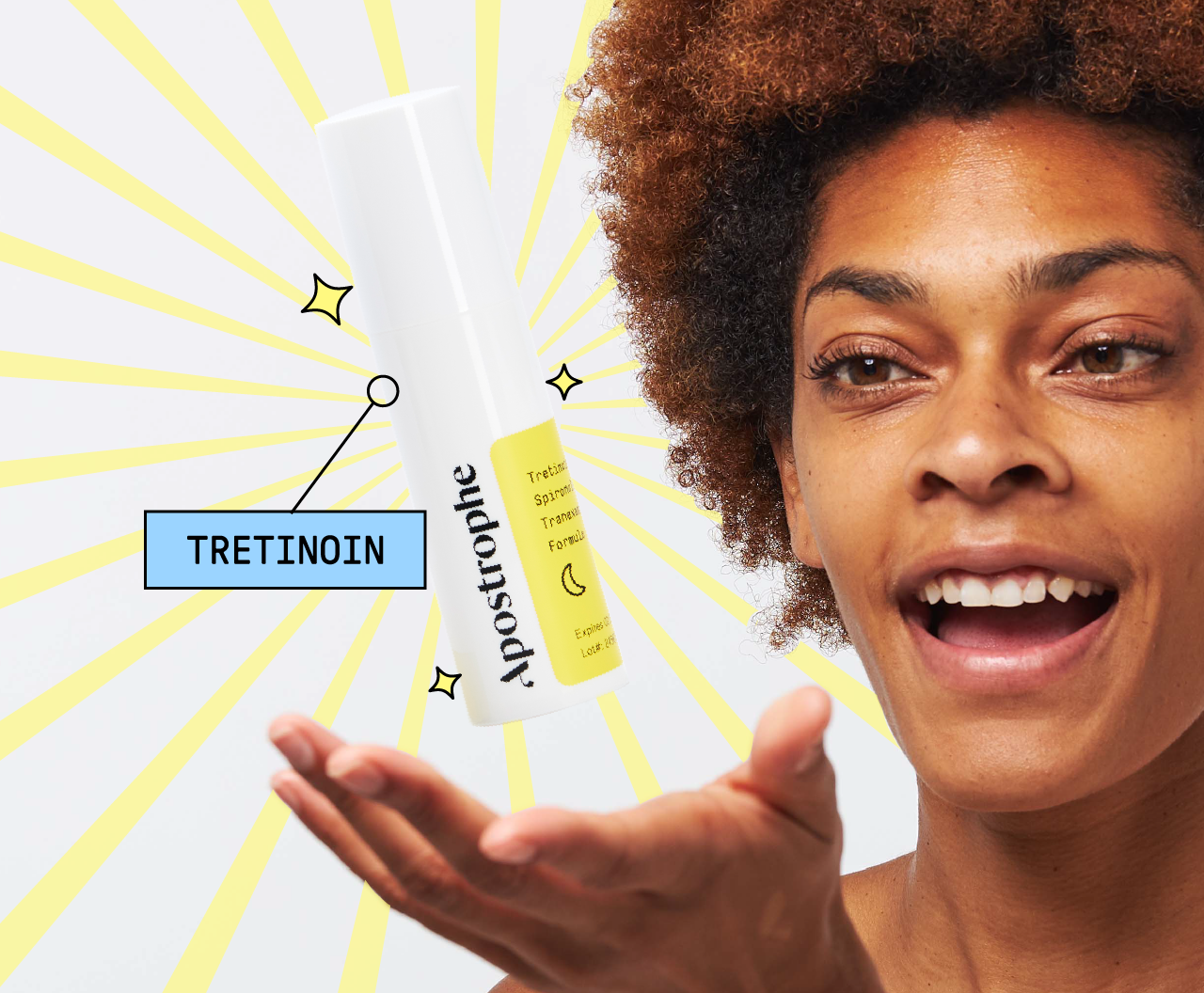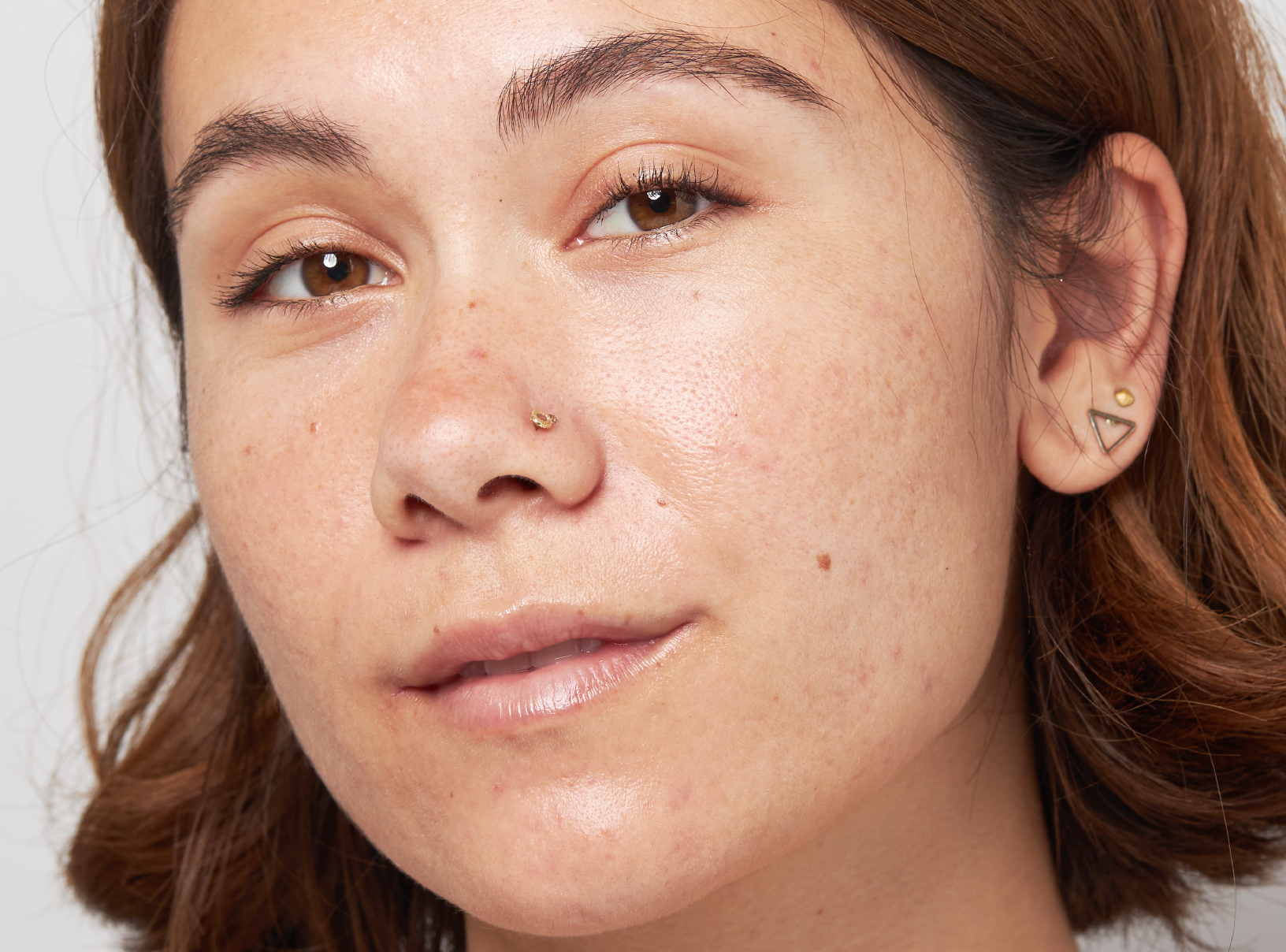Apostrophe Treatments
Everything You Need To Know About Tretinoin


SHARE
Apostrophe Treatments
Everything You Need To Know About Tretinoin
Medically reviewed by Kristin Hall, FNP
Written by Apostrophe Team
Last updated 11/3/2024
If you've ever searched for a treatment for your acne, tretinoin is something that's likely come up on your Google search. It's loved by dermatologists and has been used for decades to treat a variety of skin concerns.
Tretinoin is one of our favorite ingredients, so today we're breaking down everything you need to know about tretinoin.
What is tretinoin?
Tretinoin is a vitamin A derivative that is used to treat a variety of skin concerns. It's a prescription retinoid that's considered the gold standard in dermatology. Tretinoin is well-loved by skincare experts - and for good reason!
What does tretinoin treat?
One of the reasons why dermatologists love tretinoin is because it's multi-functional. Tretinoin treats skin concerns like acne, fine lines/wrinkles, and hyperpigmentation. Whether you're dealing with one skin condition or all three, prescription tretinoin could be a great fit for you! Let's talk about how this gold-standard ingredient can treat all of these concerns.
How does tretinoin work?
There’s a reason why tretinoin is considered mainstay in the treatment of acne and other skin conditions (like the effects of aging) and an overall gold standard derms turn to when they need help — because it works.
How tretinoin works to treat acne and reduce wrinkles is a little complicated, but essentially, it works by speeding up your body’s skin cell turnover rate — which is exactly what it sounds.
Believe it or not, every 40 to 56 days or so, our bodies regenerate our entire outer layer of skin.
Tretinoin and other retinoids work to speed up this process. Your body works to shed those old skin cells and replace them with fresh new ones, which in turn assist your pores in staying clean and clear of the excess sebum, dirt and bacteria that typically lead to acne in the first place.
It starts a kind of chain reaction that kicks your skin’s cell turnover rate into high gear, while also exfoliating and keeping your pores clear.
Tretinoin for acne
People that use tretinoin for acne typically use the cream over a period of months before seeing significant changes. In the short term, tretinoin can potentially make acne worse (a period that’s commonly known as the “tretinoin purge”) before the acne improves.
However, over the long term, tretinoin is highly effective at reducing the formation of acne and improving facial skin.
Several studies have shown that tretinoin is an effective treatment for acne:
In one 2009 study, groups of randomized participants aged 10 years and older with acne that ranged from mild to moderate were assigned tretinoin gel or a non-therapeutic substance on a daily basis over a period of 12 weeks.
The tretinoin gel groups (one used tretinoin gel 0.05 percent and the other used tretinoin gel microsphere 0.1 percent) both had significantly larger levels of improvement in acne reduction than the control group, with only mild to moderate skin-related side effects.
In another study, participants with facial acne were assigned one of three different treatments, one of which was a combination of tretinoin cream and clindamycin one percent gel.
Over a period of 12 weeks, participants in the tretinoin cream and clindamycin one percent gel group experienced a significant reduction in acne, from a baseline level of 13.70 ± 4.80 facial skin lesions to 1.30 ± 2.95 after a full 12 weeks of treatment.
Statistical analysis of data from the study suggests that the combination of tretinoin and clindamycin one percent gel outperformed benzoyl peroxide 2.5 percent gel and nadifloxacin one percent cream — another common treatment for facial acne.
However, tretinoin cream and clindamycin one percent gel were less effective when used in combination than benzoyl peroxide 2.5 percent gel and clindamycin one percent gel, which produced the biggest reduction in acne over the 12 week study period.
Tretinoin topical treatment is an effective acne treatment because it unclogs pores and keeps them clear. This vitamin A derivative can be used to treat all severities and types of acne. Whether you're dealing with blackheads, whiteheads, or more severe acne, tretinoin can help keep your acne under control long term.
Are you interested in using tretinoin for reducing and treating acne? Our guide to using tretinoin as an acne treatment covers everything you need to know about using tretinoin to clear up facial acne, from dosage protocols to results, potential side effects and more.
Tretinoin for wrinkles
In addition to reducing and preventing acne, tretinoin cream is widely used as a treatment to prevent facial skin aging.
Tretinoin has been widely studied as an anti-aging medication, with several studies looking at the substance’s potential to reverse signs of skin aging, such as the development of wrinkles, sun exposure damage and other skin blemishes.
In one study, participants were divided into two groups, one of which received non-prescription skincare products, and the other a 0.02 percent tretinoin cream in addition to moisturizing sunscreen.
Over the course of eight weeks, participants in both groups saw a significant improvement in facial skin aging, with lower periorbital wrinkle area fraction and an improvement in overall skin appearance after the treatment.
After 24 weeks of treatment, however, the tretinoin group showed a visible increase of wrinkle improvement over the non-prescription group.
Tretinoin can help treat fine lines and wrinkles by stimulating collagen production in the skin. This increase in collagen can lead to firmer, smoother, more youthful skin over time.
Are you considering tretinoin as a way to reduce the visibility of wrinkles and other age-related skin blemishes? Our guide to using tretinoin for wrinkles and skin aging goes into more detail about the anti-aging benefits of tretinoin, as well as tretinoin’s safety as an anti-aging cream.
Tretinoin for acne scars
Tretinoin's ability to treat acne scars and hyperpigmentation makes it a triple threat. It helps with exfoliating dead skin cells and resurfacing the skin to lighten dark spots, sun damage, and age spots. There are many types of acne scars, but tretinoin is best used to treat hyperpigmentation and sun-damaged skin.

CUSTOMIZED HYPERPIGMENTATION TREATMENT
Get customized treatment for your dark spots, melasma, and hyperpigmentation.
Tretinoin vs other retinoids
How is tretinoin different from other retinoids? There are many different types of retinoids, including retinol, adapalene, tretinoin, tazarotene, and more. Tretinoin is an active form of retinoic acid, so it can be quickly used by the body.
Tretinoin vs Retinol
Retinol is a gentle retinoid that's available in many over-the-counter retinol products. It's a great accessible option for preventative anti-aging, but it has not been proven to effectively treat acne. Retinol actually has to convert two times to become retinoic acid, so it takes longer to see results. The results may also not be as dramatic compared to tretinoin.
Tretinoin vs Adapalene
Adapalene is a prescription-strength retinoid that has more recently become available over-the-counter in the US. It's a great option for treating mild acne but isn't as proven for treating signs of aging. If you're looking for an affordable, accessible acne medication, adapalene is a solid choice!
Tazarotene vs Tretinoin
Tazarotene is the strongest topical retinoid and is typically prescribed for severe acne. It's stronger than tretinoin but is much more sensitizing. It's typically only prescribed to people with very resilient skin.
How to use tretinoin
Here are some derm-approved recommendations when using your tretinoin topical treatment:
Start out using tretinoin 2-3 times a week and build up to every night as tolerated.
When applying topical tretinoin, a little goes a long way. Use a pea-sized amount and dot it across the skin to make it easier to spread.
If you have dry skin or sensitive skin, try applying moisturizer before and after tretinoin. This helps to minimize sensitivity and irritation.
Keep your routine simple when starting out. Minimize use of other potentially irritating products like an alpha hydroxy acid product.
How long does it take for tretinoin to work?
Typically you will begin to see progress after 8-12 weeks. More severe acne, wrinkles, or hyperpigmentation may take longer to see results. It's important to stay consistent with your treatment for best results!
Side effects of tretinoin
Tretinoin has many amazing benefits, but it does have some side effects that are important to know.
Potential irritation - When first starting out, it can cause initial sensitivity or skin irritation like peeling, dryness, and flakiness. This is sometimes called "retinoid or retinol uglies." It can take up to 10 weeks for your skin to adjust, so be patient with your skin.
Sun Sensitivity - Tretinoin can make your skin more sensitive to the sun, especially during the first 6 months of use, so it's important to keep your skin protected. We recommend using a broad-spectrum sunscreen and a wide-brimmed hat for additional protection. Good sun protection will also prevent skin aging and dark spots, so you’ll be helping yourself in more ways than one!
The Tretinoin Purge - Tretinoin increases your skin's cell turnover rate, which may cause an initial "purge" of increased breakouts. Your skin purges because it's bringing any dead skin cells and build up in the pores to the surface. It can last anywhere from a few weeks to a few months, but clear skin is on the other side.
There aren't many drug interactions between tretinoin and other ingredients with one exception: benzoyl peroxide. Benzoyl peroxide actually inactivates tretinoin, so we recommend using these two ingredients separately.
How to get tretinoin
Unlike retinol, you can't buy tretinoin over-the-counter. Because it's prescription-strength, it must be given under the guidance of a medical provider to ensure you will have the best results. Luckily, Apostrophe makes it simple to get professional care online.
Apostrophe tretinoin formula contains 4% niacinamide to help improve tolerability. Niacinamide and tretinoin are a great pair because niacinamide helps to improve your skin's natural barrier function.
At Apostrophe, we also offer access to tretinoin combined with other acne-fighting medications like azelaic acid, clindamycin, topical spironolactone, and more. This can help treat multiple skin concerns or types of acne.
If you're ready to add tretinoin to your skincare routine, get started with Apostrophe today. If prescribed, you'll receive your customized acne treatment plan crafted by an expert dermatology team. We're excited to help you on your journey to healthy skin.
Like what you just read? Sign up for our email list to get the scoop on skincare science delivered straight to your inbox.
Shop this post

Tretinoin
Like what you just read? Sign up for our email list to get the scoop on skincare science delivered straight to your inbox.

Deep Dives
A dermatologist shares his thoughts on the recent studies about benzoyl peroxide and benzene.
Read More
Education
What is milia?
What is milia? Today, we’re jumping into one type of bump that you may have heard about most commonly in infants — milia.
Read More
Education
Best moisturizer for acne-prone skin
If you have combination acne-prone skin, figuring out which moisturizer is best for your skin might be tough. In this guide, we break down the best moisturizer for combination, acne-prone skin.
Read More